- Prelude
- Editorial
- A time to Act
- Raja Ravi Varma: The painter who made the gods human
- Rabindranath as Painter
- Gaganendranath: Painter and Personality
- Abanindranath Tagore: a reappraisal
- Where Existentialism meets Exiledom
- Nandalal Bose
- Jamini Roy's Art in Retrospect
- Sailoz: The Inerasable Stamp
- Amrita Sher-Gil
- Calcutta's Best Kept Secret: The Marble Palace
- Art is Enigmatic
- A few tools to protect the French culture
- The exact discipline germinates the seemingly easiness
- Symbols of Monarchy, power and wealth the Turban Ornaments of the Nizams
- The Bell Telephone
- The Pride of India
- Tapas Konar Visualizing the mystic
- Theyyam
- Our Artists vs. their Artists
- Dragon boom or bubble?
- What Happened and What's Forthcoming
- Art Bengaluru
- Musings from Chennai
- Art Events Kolkata: May – June 2011
- Mumbai Art Sighting
- Previews
- In the News
ART news & views
Amrita Sher-Gil
Volume: 3 Issue No: 18 Month: 7 Year: 2011
by Uma Prakash
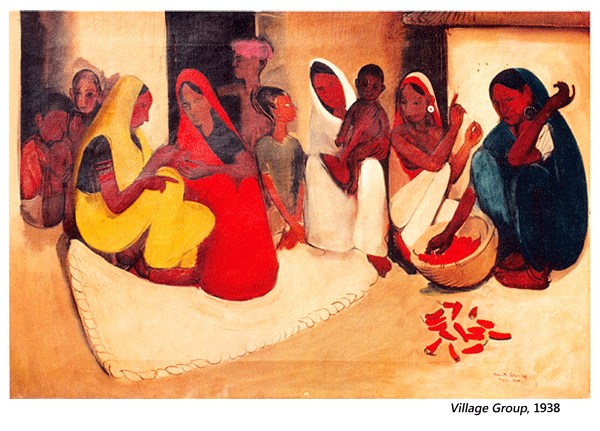
“I am an individualist, evolving a new technique, which, though not necessarily Indian in the traditional sense of the word, will yet be fundamentally Indian in spirit. With the eternal significance of form and color”- Amrita Sher-Gil.
Amrita Sher-Gil.
Amrita Sher-Gil's free spirit and artistic prowess completely captured and inspired Indian artist for generations to come. She was one of the most celebrated painters of pre-independence India and among the initiator of Indian modern art, merging European and Hungarian traditions with ancient Indian art. She died at the age 28 and left behind an oeuvre of almost two hundred brilliant paintings. Sher-Gil was a woman far ahead of her time. Her legendary charm enraptured many - including, it is believed, India's future prime minister, Jawaharlal Nehru.
She was born in Budapet in 1913 to a Hungarian mother Marie Antoinette Gottesmann and an aristocratic father Sardar Umrao Singh Sher-Gil of Majitha. A world artist she was a perfect blend of East and West. She and her younger sister Indira spent their early childhood in Budapest. Her mother's passion for music and her father's deep interest in Sanskrit and Persian exposed Sher-Gil to a life rich in art and culture.
Amrita started drawing and painting at the age of five and later illustrated her mother's enchanting Hungarian fairy tales. In 1921 the Sher-Gil family returned to India, and made their home in Simla. However in 1923, Amrita's mother's involvement with an Italian sculptor inspired her to move to Italy along with Amrita, who was enrolled at Santa Annunziata, an Art School at Florence,  giving her brief exposure to works of Italian masters.
giving her brief exposure to works of Italian masters.
The drawings and watercolours Amrita did between the ages of eleven and fourteen were European in content. Naked women and landscapes seemed to evoke her self exploration. Painter turned Indologist. Ervin Baktay was Amrita's uncle. He soon became her guide and mentor giving her an academic foundation to grow on. He also encouraged her to study from life by using her servants as models. It is the lasting memories of these models that eventually lead to her return to India. She would attentively listen to his criticism and told him later 'It is to you I owe my skill in drawing'.
Realizing her daughter's talent for art Marie moved her sixteen years old Amrita to Paris to hone her artistic talent. Here she trained as a painter at Grande Chaumiere under Pierre Vaillant and later at École des Beaux-Arts (193034).Inspired by Paul Cézanne and Paul Gauguin, she was also influenced by her teacher Lucien Simon.
In Paris her mode of painting was western as it reflected the art of the Bohemian circles of the city in the early 1930s; she was in her element with her avant garde friends of the art and literary world. Here she painted Young Girls in 1932 her first significant work, which led to her election as an Associate of the Grand Salon in Paris in 1933, making her the youngest ever and the only Asian to have received this recognition hence. In this charming painting her sister Indira sits on the left clothed in chic European garb,  while the partially undressed figure in the foreground is a French friend, Denise Proutaux.
while the partially undressed figure in the foreground is a French friend, Denise Proutaux.
In 1934, while in Europe she "began to be haunted by an intense longing to return to India," In response to her father's hesitancy about her proposed return to India from Europe, claiming that she did not understand Indian art and philosophy, she wrote "I wish to return primarily in interest of my artistic development ...... Our long stay in Europe has aided me to discover as it were, India. Modern art has led me to the comprehension and appreciation of Indian painting and sculpture. It seems paradoxical, but I know for certain that, had we not come away to Europe, I should perhaps never have realised that a fresco from Ajanta or a small piece of sculpture in the Musée Guimet is worth more than the whole Renaissance.In short, now I wish to go back to appreciate India and its worth ...”
She had "feeling in some strange way that there lay my destiny as a painter", as she later wrote about her return to India, in the same year. Once back home she was all set to discover her Indian tradition and art practices by traveling and acquainting herself with her Indian roots. It was a journey that completely absorbed her. She embarked on a visual language that would become an inspiration for generations to come. She was captivated by the Mughal, Pahari, Kangra and Basholi schools of painting and cave paintings at Ajanta Caves.
Her new work was the blend of her travels, her innate perception and a narrative that created a visual language akin to Indian miniatures. 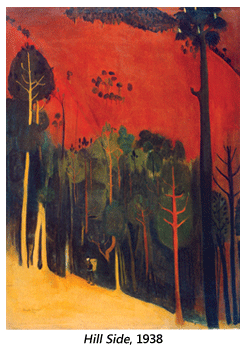 However her canvases took on earthier, flat tones. Having mastered western techniques of oil painting she created vignette of Indian rural life, with a flair that made the most ordinary situation appear extraordinary. In her inimitable style she had captured India like nobody had done before, focusing on the life of the poor rural Indian, narrating their stories in a language that saw the emergence of contemporary Indian art. She moved away from colonial circles to generate an Indian sense of modernity. She along with Rabindranath Tagore heralded a cultural freedom that completely overtook the colonial views. They inspired artists to create India in a visual narrative that was universal.
However her canvases took on earthier, flat tones. Having mastered western techniques of oil painting she created vignette of Indian rural life, with a flair that made the most ordinary situation appear extraordinary. In her inimitable style she had captured India like nobody had done before, focusing on the life of the poor rural Indian, narrating their stories in a language that saw the emergence of contemporary Indian art. She moved away from colonial circles to generate an Indian sense of modernity. She along with Rabindranath Tagore heralded a cultural freedom that completely overtook the colonial views. They inspired artists to create India in a visual narrative that was universal.
Sher-Gil's work had a wide appeal. "[Hers] is an art which moves naturally towards the melancholy and tragic, while keeping its eye fixed firmly on high ideals of beauty” wrote Salman Rushdie. She was a strong willed beautiful woman who declared “You will think I am self-opinionated,” in 1934, aged just 21, “but I will stick to my intolerant ideas and to my conviction”. She went on to become an enlightened artist whose taste in art and literature ranged from Rousseau, Verlaine, Proust, Renoir, Breughel to the splendor of the Ellora carvings and Ajanta cave paintings revealing her heightened sensitivity.
Sensuality and beauty were important for Amrita. While referring to the Cochin frescoes in a passionate letter to close friend Karl Khandalavala, the artist says “all art, not excluding religious art, has come into being because of sensuality: sensuality so great that it overflows the boundaries of the physical.”
Sher Gil exudes sensuality in Woman resting on charpoy 1940 through the passionate red apparel worn by the woman. 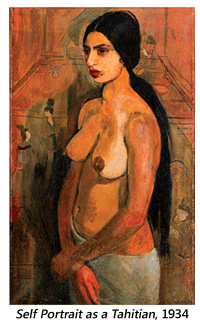 The upward angle of her leg insinuates a longing and anticipation aiming at the woman's concealed sexual desires. Sher-Gil's woman is rustic, earthy and modern. The artist displays a quiet understanding of the psychology of the feudal Indian woman whose restful appearance seems to camouflage her turmoil of suppressed desires. The erotically suggestive pose along with the tilted charpoy insinuates a strange intimacy.
The upward angle of her leg insinuates a longing and anticipation aiming at the woman's concealed sexual desires. Sher-Gil's woman is rustic, earthy and modern. The artist displays a quiet understanding of the psychology of the feudal Indian woman whose restful appearance seems to camouflage her turmoil of suppressed desires. The erotically suggestive pose along with the tilted charpoy insinuates a strange intimacy.
Amrita's time spent with a group of women, which included her female relatives and servants, gave her an insight into the social and psychological problems of the cloistered life of traditionally oriented Indian women. She understood their suppressed desires, which she depicted with great panache in her paintings, like the eroticism that exudes from The Swing 1940 where a languid sexuality pervades as the women begin to play with the swing she saw the world through color and invited the viewer to share her unique visual experience.
In Bride's Toilet the artist captures the gentleness and innocence of the bride in her inimitable style. Once again her brilliance and flair injects life into the feminine activity of the women. Sher-Gil had a special fascination for the color red that is evident as it stands out against the dark tones of her back ground. 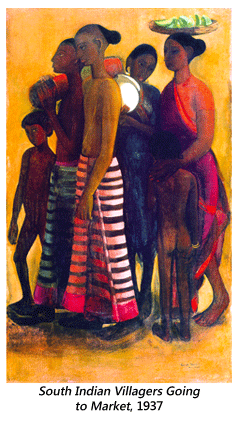 Here different shades of red are highlighted by a contrasting green and a striking white color.
Here different shades of red are highlighted by a contrasting green and a striking white color.
Sher-Gil has used white in the most breathtaking fashion in many of her paintings as is evident in The Ancient Story Teller 1940, Hill Women1935 and Brahmachari's. 1937.
The white walls and dome in the horizon in The Ancient Storyteller add a depth to the painting. The white veil worn in the foreground stands out in contrast to the other garments in Hill Women and piece des resistance are the white dhotis of the Brahmacharis which have been the inspiration of many artist of today. The grouping of people added yet another dimension to her work like Three Women where all are pensive with soulful exuding a quiet stillness.
Her travels to South India impacted her even more. She discovered the Padmanabhapuram and Mattancheri murals or frescos. In a letter to her Sister Indu she tells of the frescos found in Cochin-
“I spend my days morning and evening, that is to say till the light fails, at a deserted palace here. It contains some perfectly marvelous old paintings that haven't been discovered yet. Nobody knows about them and the local people, even so called responsible people, like the Diwan would destroy them, I am sure. If that were in their power- because some of the panels depict erotic scenes. Animals and birds are copulating with the utmost candor, but curiously the human figures are never depicted in the act…. It is only when one starts copying them that one realizes what an astounding technique these people had and what an amazing knowledge of form and power of observation they possessed. Curiously enough unlike the slender forms of Ajanta, 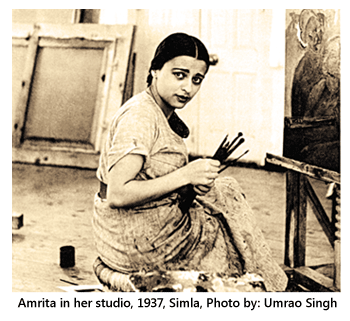 the figures are extremely heavy here. The drawing perhaps the most powerful I have seen.”
the figures are extremely heavy here. The drawing perhaps the most powerful I have seen.”
The Cochin frescoes return in a passionate letter to Khandalavala, and it is clear they influenced her deeply, just as Breughel did, and Renoir. She became convinced that “all art, not excluding religious art, has come into being because of sensuality: sensuality so great that it overflows the boundaries of the physical.”
Amrita Sher Gil's contribution to Indian art was enormous. Besides uplifting the spirit of womanhood she created a visual language that found a balance between tradition and modernism. She injected a new dynamism into the Indian art scene. Her strong poignant response to the life of village India - was projected in compositions, which brilliantly combined Indian and Post-impressionist styles, particularly that of Gaugin. Sher Gil showed the rich milieu, available to Indian artists and highlighted the significance of technical `painterly' values in art.
Notes
- Amrita Sher-Gil “Evolution of my Art” reprinted Amrita Sher-Gil says by Geeta Kapoor, Gulammohammed Sheikh, KG Subramanyan and Vivan Sundaram ,Bombay, Marg Publication Vol XXV No 2 1972
- Novelist Salman Rushdie, writes in his introduction to Vivan Sundaram's volume: Amrita Sher-Gil: A Self-Portrait in Letters and Writings
- Nilima Sheikh: Expressions and Evocations Marg Publications
- Vivan Sundaram -Amrita Sher-Gil- Life and Work
- Letter from Budapest to her parents
- Letter to her sister Indira from Cochin
- Letter to Karl Khandalavala